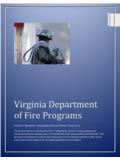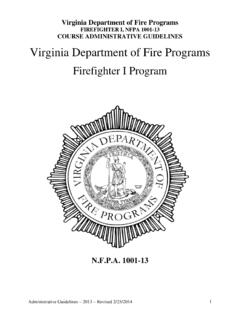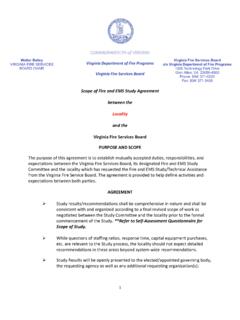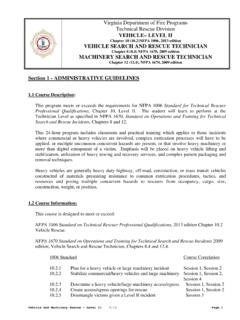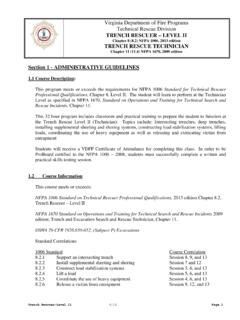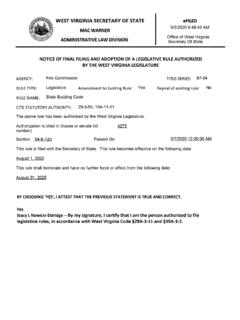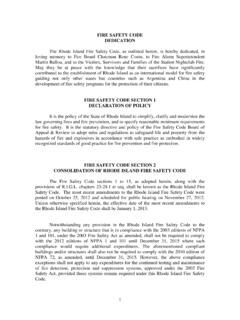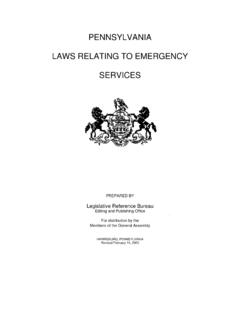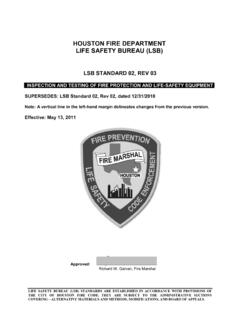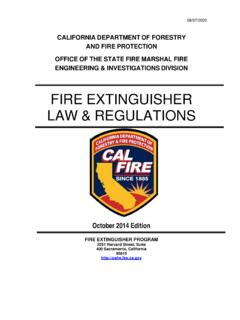Transcription of VIRGINIA FIRE SAFETY REGULATIONS
1 STATE CORPORATION COMMISSION Adopting agency amended 1981: Adopted by the State BOARD OF HOUSING AND COMMUNITY DEVELOPMENT Effective July 16, 1982 VIRGINIA fire SAFETY REGULATIONS Maintenance Requirements for Existing Buildings According to VIRGINIA s building and fire codes, an existing building is required to be maintained in accordance with the building code that was in effect at the time the building was constructed and with the requirements of any applicable maintenance provisions of VIRGINIA s fire code. This means that many conditions identified in an older building that may not be in full compliance with today s codes are acceptable because these conditions were okay at the time the building was constructed. As long as the use of the building is not changed, the building owner is not legally required to retrofit the building to meet the current code.
2 For example, a room used for spray application of flammable finishes that has been in use since before 1973 is not sprinklered. Because the code that was in effect at the time the building was built did not require a paint spray room to be sprinklered, the condition is allowed to continue even though the currently applicable fire prevention code requires sprinklers in this situation ( ). Yet the room is still required to meet other fire prevention code requirements. For example, the space must be kept free of accumulated residues and solvent soaked rags must be disposed of in metal cans ( ). Determination of Maintenance Requirements Many buildings in the State are required by law to be inspected by a fire marshal on an annual basis. In order for the inspection to be performed properly, the inspector should know the applicable codes.
3 While the maintenance requirements are readily available in the current edition of the VIRGINIA Statewide fire Prevention Code, it is not quite as easy to find the requirements that were in effect at the time the building was built. Only through research of the history of VIRGINIA s building codes can that information be gathered. In attempt to facilitate this research procedure, the following printing of the first building code enforced in VIRGINIA is provided. Research begins with the determination of the year the building was built and what the building was used for at that time. This information is provided on the Certificate of Occupancy (CO) of the building in question. The Office of the Building Official in the county, town or city that the building is located should have copy of the Certificate of Occupancy (CO) available upon request.
4 If a CO is not available, one must use other means to determine the year of construction, its original use and any change of use that may have occurred over the years. Once the year is known, the exact code requirements can be determined by researching the history of VIRGINIA s building codes. If the building was built before 1973, a locally enforced building code may also be applicable. This information should be available at the local code enforcement office. If the building is used as a hotel, nursing home, adult care facility, or a state owned dorm, retrofit requirements for fire sprinkler or smoke detection may also apply. Retrofit requirements adopted by VIRGINIA can be found in the current edition of the Uniform Statewide Building Code, Part I, Article 3. History of VIRGINIA s Building and Maintenance Codes The VIRGINIA fire SAFETY REGULATIONS is the first statewide applied building code to be adopted in VIRGINIA .
5 It was adopted April 12, 1949. The enabling law was the VIRGINIA fire Hazards Law (see Appendix A of this printing). This law was renamed in 1981 the VIRGINIA Public Building SAFETY Law, thus the REGULATIONS were also renamed the VIRGINIA Public Building SAFETY REGULATIONS (VPBSR). Therefore the proper legal title for these REGULATIONS is the VPBSR. When originally adopted, these REGULATIONS listed retrofit requirements applicable to buildings built prior to the code s adoption in 1949 and requirements for new construction. Between 1949 and 1981, the VPBSR was the applicable maintenance code ( fire prevention code) used during fire marshal inspections. In 1973, 36-98 Code of VIRGINIA became effective directing the promulgation of the Uniform Statewide Building Code (USBC). The USBC superseded the VPBSR as applicable to new construction.
6 At that time, the VPBSR became a maintenance code only. In 1981, the law was amended to require buildings built after USBC was in effect to be maintained in accordance with the fire SAFETY requirements listed in the USBC. This means the VPBSR is now used only as a maintenance code for buildings built before 1973. When the fire Hazards Law was repealed in 1986 and replaced with 27-30 through 27-101, the VIRGINIA Statewide fire Prevention Code (VSFPC) was adopted. The new fire prevention code replaced the VPBSR as the applicable maintenance code for all buildings in the State. At that point on, the VBPSR is used only to clarify the construction requirements in effect at the time a building is constructed. A summary of the history of the VIRGINIA Public Building SAFETY REGULATIONS is provided in Addendum E.
7 The following reprints of the Prefaces included in various printings of the REGULATIONS provide addition documentation of the history of the code s application and the changes that took place over the years. 1953 Printing; INFORMATION FOR USERS OF THIS CODE THIS CODE IS ARRANGED in two parts. Part One consists of Articles 1 through 7 and applies to buildings erected after April 12, 1949. Part Two applies to buildings erected before April 12, 1949, and consists of Articles 11 through 17. June 1977 Printing; INFORMATION FOR USERS OF THIS CODE THIS CODE IS ARRANGED in two parts. Part One consists of Articles 1 through 7 and applies to buildings erected after April 12, 1949, and prior to the effective date of the Uniform Statewide Building Code. In general, buildings for which plans were completed and the building permit issued after September 1, 1973, are subject to the requirements of the Uniform Statewide Building Code.
8 Part Two applies to buildings erected before April 12, 1949, and consists of Articles 11 through 17. 1981 Edition (effective JULY 16, 1982); PREFACE Changes in the 1981 Edition The 1981 Edition reflects certain changes: (1) because the VIRGINIA fire SAFETY Law was renamed the VIRGINIA Public Building SAFETY Law, the name of the VIRGINIA fire SAFETY REGULATIONS was changed to the VIRGINIA Public Building SAFETY REGULATIONS ; (2) PART THREE has been added to cover the duties assigned by law to the State fire marshal for maintenance of fire SAFETY in public buildings constructed under the Uniform Statewide Building Code (USBC). For such buildings the fire SAFETY requirements of the USBC are adopted by reference. Coordination with Local Building Officials Plans Review: When requested by the local building official, the State fire marshal will review plans for construction or alteration of public buildings.
9 An advisory report of any items that do not meet the applicable fire SAFETY requirements will be reported to the building official. The State fire marshal also reviews all plans for State-owned buildings. Inspections: Possible violations of the fire SAFETY requirements of the USBC that are discovered during routine inspections by the State fire marshal are discussed with the local building official to make certain that both agencies agree on the proper application of the code. The items on which both agree will be cited in fire marshal s report. Correction of Violations: When construction work is needed to correct fire SAFETY violations, the person responsible is advised that a building permit must be obtained from the local building official.
10 Also, such changes must be done in a manner that does not create violations of the USBC. Future Amendments The Board of Housing and Community Development is responsible for keeping the Public Building SAFETY REGULATIONS up to date. Comments or suggestions for amendments should be addressed to the Board of Housing and Community Development. GUIDE TO MAJOR DIVISIONS OF THE 1981 EDITION VIRGINIA PUBLIC BUILDING SAFETY REGULATIONS PART ONE Buildings Constructed Between April 12, 1949 and September 1, 1973 PART TWO Buildings Constructed Before April 12, 1949 PART THREE Buildings Subject to the Uniform Statewide Building Code, Beginning September 1, 1973 2006 Printing This printing is a reproduction of the 1953 text. The amendments are included in italicized text below the amended section headed with the date of the amendment.
